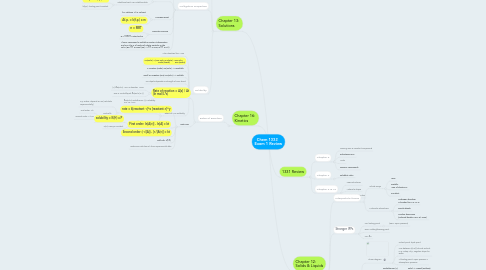
1. Chapter 13: Solutions
1.1. Concentration
1.1.1. mass % solute = (g solute / g solution) x 100%
1.1.2. volume %
1.1.3. mole fraction, X solute = mol solute / total mol
1.1.4. Molarity, M = mol solute / L solution
1.1.5. molality, m = mol solute / kg solvent
1.2. Colligative Properties
1.2.1. Vapor pressure
1.2.1.1. solute - non-volatile, non-electrolyte
1.2.1.1.1. v.p. solution = (v.p solvent) (X solvent)
1.2.1.2. Solute particles get in the way
1.2.1.3. volatile solvent & volatile solute
1.2.1.3.1. v.p. sol'n = (X solv.) (v.p. solv.) + (X solute) (v.p. solute)
1.2.2. Boiling point
1.2.2.1. b.p. solution > b.p. solvent
1.2.2.2. volatile solvent, non-volatile solute
1.2.2.2.1. Δb.p. = k(bp) x m
1.2.2.2.2. k(b.p.): boiling point constant
1.2.3. Freezing point
1.2.3.1. f.p. solution < f.p. solvent
1.2.3.2. Δf.p. = k(f.p.) x m
1.2.4. Osmotic pressure
1.2.4.1. π = MRT
1.2.4.2. R = 0.0821 L*atm/mol*K
1.2.5. If ionic compound is soluble in water, it dissociates and incr. the # of moles of solute particles in the sol'n. (Ex: 0.1 m NaCl (aq) --> 0.1 m Na+ & 0.1 m Cl-)
1.3. Solubility
1.3.1. "Like dissolves like": IPFs
1.3.2. ΔH(sol'n) = (IMF solv. & solute) - IMF sol'n endo (break) exo (make)
1.3.3. V. positive (endo) ΔH(sol'n) --> insoluble
1.3.4. Small or negative (exo) ΔH(sol'n) --> soluble
1.3.5. Ion-dipole depends on strength of ionic bond
1.3.6. ΔS: change in entropy (disorder)
1.3.6.1. (+) ΔS(sol'n): incr. in disorder, "nice"
1.3.6.2. Gas in a solid/liquid: ΔS(sol'n) is (-)
1.3.7. Effect of T on solubility
1.3.7.1. ΔH(sol'n) endothermic (+): solubility incr. as T incr.
1.3.7.2. ΔH(sol'n) exothermic (-): solubility decr. as T incr.
1.3.7.3. For (g) only: Henry's Law
1.3.7.3.1. solubility = K(H) x P
1.3.7.3.2. K(H), Henry's constant
2. Chapter 16: Kinetics
2.1. Rates of Reaction
2.1.1. Rate of reaction = Δ[x] / Δt (In mol/L*s)
2.1.2. Rate Law
2.1.2.1. rate = k[reactant 1]^x [reactant 2]^y
2.1.2.1.1. x,y: orders, depend on rxn (calculate experimentally)
2.1.2.1.2. Units of k:
2.1.2.2. First order: ln[A(0)] - ln[A] = kt
2.1.2.3. Second order: (1/[A]) - [1/[A(0)] = kt
2.1.2.4. Half-Life, t(1/2)
2.1.2.5. Determine rate law & k from experimental data
3. 1331 Review
3.1. Chapter 2
3.1.1. Naming ionic & covalent compounds
3.1.2. Polyatomic ions
3.1.3. Acids
3.1.4. Organic compounds
3.2. Chapter 4
3.2.1. Solubility rules
3.3. Chapter 9 & 10
3.3.1. Lewis Structures
3.3.2. Molecular shape
3.3.3. Polarity of molecules
4. Chapter 12: Solids & Liquids
4.1. Interparticle forces
4.1.1. Infinite arrays
4.1.1.1. Ionic
4.1.1.2. Metallic "sea of electrons"
4.1.1.3. Covalent
4.1.2. Molecular interactions
4.1.2.1. Hydrogen bonding H bonded to F, O, or N
4.1.2.2. Dipole-dipole
4.1.2.3. London dispersion (induced dipoles, incr. w/ mass)
4.2. Stronger IPFs
4.2.1. Incr. boiling point
4.2.1.1. (Decr. vapor pressure)
4.2.2. Decr. melting/freezing point
4.2.3. Incr. ΔH
4.3. Phase Changes
4.3.1. Phase diagram
4.3.1.1. Critical point, triple point
4.3.1.2. Line between (s) & (l) almost vertical: m.p. indep. of p; negative slope for water
4.3.1.3. At boiling point: vapor pressure = atmospheric pressure
4.3.2. ΔH(fus)
4.3.2.1. Endothermic (+)
4.3.2.1.1. Solid --> Liquid (melting)
4.3.2.2. Exothermic (-)
4.3.2.2.1. Liquid --> Solid (freezing)
4.3.3. ΔH(vap)
4.3.3.1. Endothermic (+)
4.3.3.1.1. Liquid --> Gas (vaporization)
4.3.3.2. Exothermic (-)
4.3.3.2.1. Gas --> Liquid (condensation)
4.3.3.3. ΔH°(vap) > ΔH°(fus)
4.3.4. ΔH(subl)
4.3.4.1. Endothermic (+)
4.3.4.1.1. Solid --> Gas (sublimation)
4.3.4.2. Exothermic (-)
4.3.4.2.1. Gas --> Solid (deposition)
4.4. Heating curves
4.4.1. Graph T vs q
4.4.1.1. Heating -->
4.4.1.2. Cooling <--
4.4.2. Heat material: q = mcΔT
4.4.3. Phase change: q = ΔH° x n

